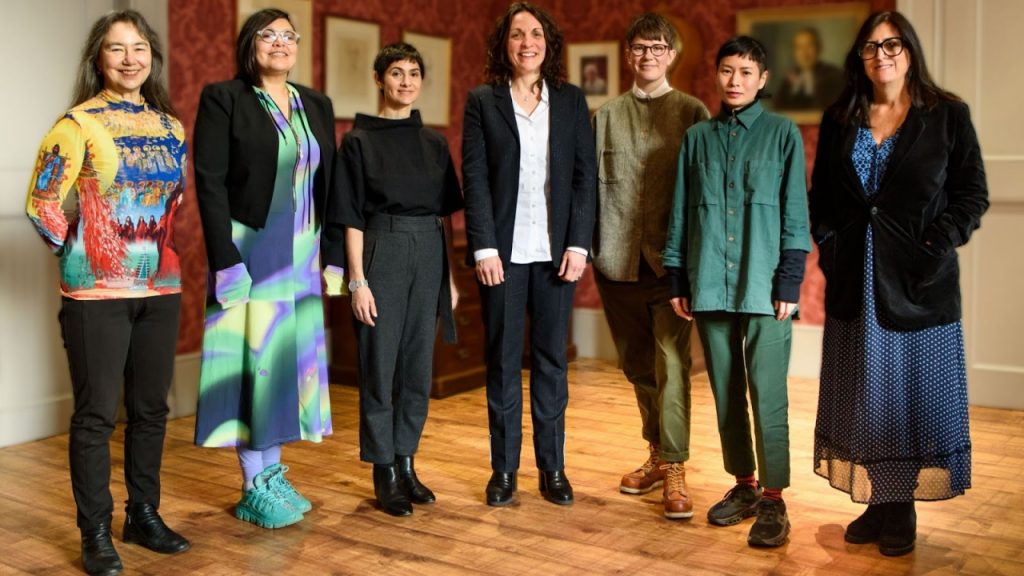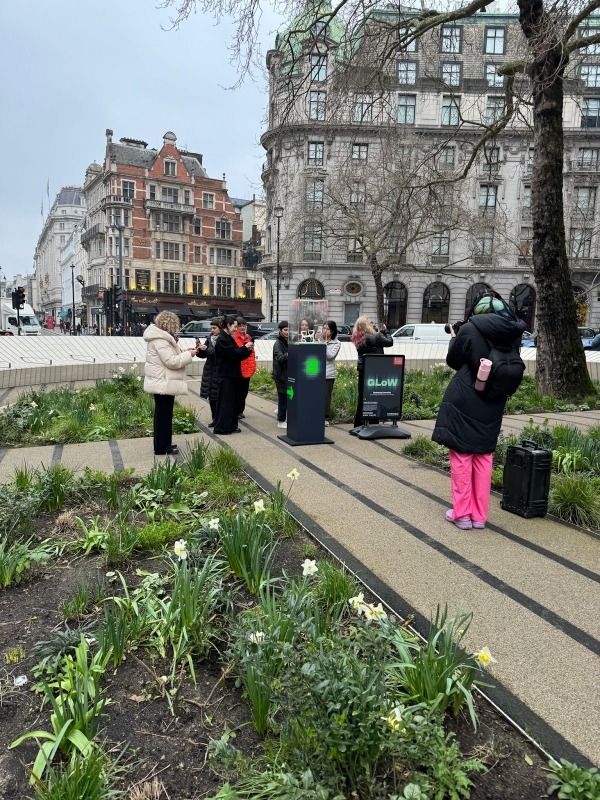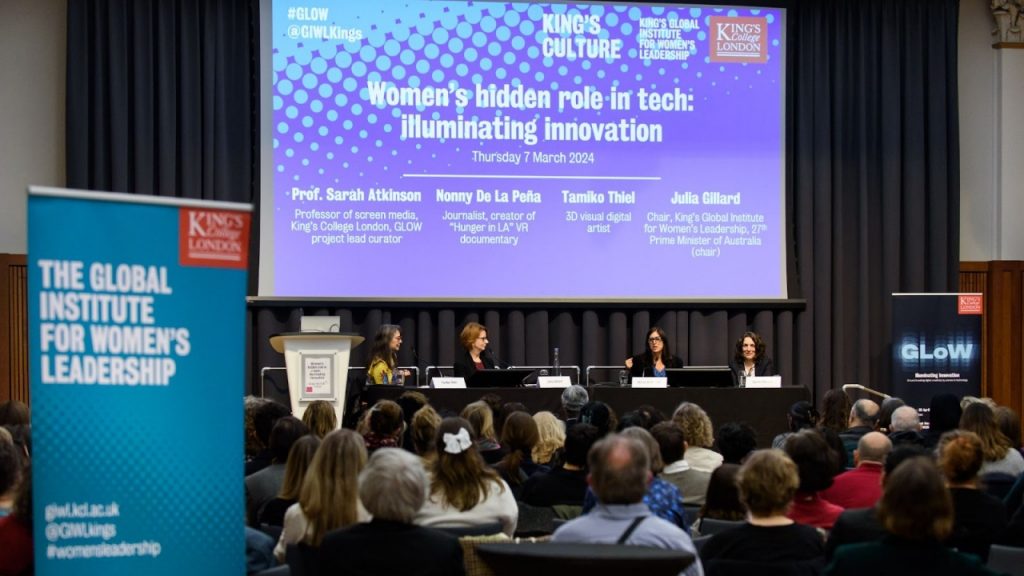There is a repeated cycle in every new form of technology when it emerges, when the rules haven’t yet been written or established, it is very inclusive and many people can experiment with it. It is in those early stages when wonderful projects and discoveries emerge.
SARAH ATKINSON (GLOW: Illuminating Innovation)
Cover: Second Nature in St Mary le Strand Church by Artist Urban Projections (Rebecca Smith) part of GLOW: Illuminating Innovation.
GLOW: Illuminating Innovation is a multi-sited exhibition taking place now in London until April 20th. The event offers a global and historical perspective on women’s artistic technological creation, showcasing cutting-edge works by artists using immersive technologies. From Violeta Ayala, Yarli Allison, Lisa Jamhoury, and Rebecca Smith’s brand-new commissioned works, which use artificial intelligence, augmented reality, 3D printing and design volumetric lighting and immersive audio, to the historical pieces and innovations by Rebecca Allen, Donna Cox, Nonny de la Peña, Toni Dove, Claudia Hart, Margaret Minsky, Ellen Sandor, Nicole Stenger, Tamiko Thiel, and Peggy Weil.
We met with Sarah Atkinson, curator of the exhibition and Professor at King’s College London, to unfold the details and the concept behind the event and to know more about the artists’ work and the development of GLOW: Illuminating Innovation.
What inspired you to create the GLOW: Illuminating Innovation, and what are the goals for the event?
GLOW: Illuminating Innovation emerges from a book project Mixed Realities: Gender and Emergent Media, which I wrote together with my colleague Vicki Callahan from the University of Southern California as a result of the research we did from 2016 to 2022. It involved interviewing 140 women, non-binary and trans people across over 17 countries, who work in immersive media sectors (transmedia, VR, AR, mixed media etc.). The book will be published in 2025 and we felt that because these new technologies are becoming increasingly popular and commercialised, the stories we collected had to be shared much sooner. The GLOW: Illuminating Innovation exhibition is a great way to disseminate those stories and presenting it in central London allows us to bring these to a much wider audience.

We often talk about technological innovation and new media. How can we categorise a technology as such?
Many of these technologies have existed in some form for over a century, for example, immersive media existed in the wonderfully encapsulating rotunda 360º paintings, where people could walk around an immersive landscape. What we refer to as ‘new’ technologies often become old very quickly and concepts such as XR, VR, AR can be confusing for the general audience. If we want to engage a wider audience, we need to reduce the confusing technical terminology. The term ‘immersive’ is now so overused that it is at risk of becoming meaningless. I tend to use the term emergent media to account for the fact that mediums might not necessarily be new, but the ways that they can be adopted, used and integrated as tools for storytelling and communication are very often innovative and original. The stories that are told can be much more powerful and memorable than the media itself and you find that experiences that are simply fetishising the novelty of the technology, are far less effective and impactful than when the medium is chosen as the most appropriate form to reveal a new perspective or to tell a new story.

Please, share with us more about the process of researching and selecting the featured artists and their works for GLOW: Illuminating Innovation and which criteria you considered. What were you particularly looking for when you commissioned the works by Violeta Ayala, Yarli Allison, Lisa Jamhoury, and Rebecca Smith?
I received an Arts & Humanities Research Council (AHRC) Research Development & Engagement Fellowship. Part of the funding was used to commission four brand new pieces from creators using the latest technologists in cutting-edge ways. We published a global open call for which we received many applications, and a panel of experts (including from King’s Culture, King’s Digital Lab,The National Gallery, Electric South and GAZELL.iO) selected four artists: Violeta Ayala, Yarli Allison, Lisa Jamhoury, and Rebecca Smith. The artists engaged in a six-month programme of technological experimentation and creation which resulted in the brand new works exhibited as part of GLOW: Illuminating Innovation.

For the other exhibition pieces, we really wanted to show some key discoveries and innovations that have been hidden in history: works that have been created in the past by artists who have gone on to have sustained and prolific careers. Some of the showcased artists including Rebecca Allen, Peggy Weil and Tamiko Thiel created ground-breaking innovations in the 80s and 90s. For example, Rebecca Allen created the first 3D female animated figure, and Peggy Weil made the first CGI text to speech responsive animated imagery: an early version of today’s deep fake technology. Tamiko Thiel who was one of the first people to create graphical virtual worlds using text-based coding, before the availability of graphical user interfaces, and Nonny De La Peña’s 2012 work Hunger in LA led to the development of the first walk-around virtual reality headset. Of course, there are many more talented and innovative creators who have not been included who we haven’t yet heard about because narratives of technological innovation have been dominated by a very limited number of voices in mainstream media.
The Curiosity Cabinet shows the stories of remarkable discoveries that have been made by women artists from the 1980s to 2010s and that the majority of the audience might not know about. How do you envision making a difference so that future generations have more prominent diverse role models and references from early stages of education?
There is a repeated cycle in every new form of technology when it emerges, when the rules haven’t yet been written or established, it is very inclusive and many people can experiment with it. It is in those early stages when wonderful projects and discoveries emerge, but as soon as these new technologies become professionalised and commercialised, investment and funding tends to go towards a very limited demographic. This means many of us do not see ourselves represented in the field once it becomes mainstream. This has happened in the film industry, in computer coding, in electronic music and audio production, etc. all areas in which a lot of women have created new and alternative forms of storytelling and experimentation at the beginning. We now see the same happening with immersive technologies. This has been the main motivation behind the research and the GLOW: Illuminating Innovation exhibition. We hope this will have a ripple effect and will reach a much wider audience who will be able to access a more diverse canon of references. Young people need to see all kinds of people doing different jobs and activities across all sectors in society. It can very often appear that some sectors are dominated by men, but that is not always the case. Since the exhibition, many people have made suggestions about artists and innovators we could have included which has been brilliant as it shows that what we are showing is just the tip of the iceberg of what is actually out there.

How was the process of reaching such a variety of artists from different contexts and how do we minimise the differences within the access to technology and finance that can impact artists’ creativity?
We used a snowball approach with our research. When we interviewed someone, we asked them to recommend other people working in the field. That way we managed to include a wide span of people from diverse perspectives and from different career levels. Within the sector there is a strong sense of community, there are a lot of women-only creative groups, many non-binary and trans communities, which have grown significantly, especially during the pandemic, when people were reliant on online modes of communication including social VR. These groups offer support to each other including consultancy, and through mentorship programmes, etc. and are very open to connect. Of course, access to technology significantly differs across global contexts, and countries have distinctive economic and political challenges. With GLOW: Illuminating Innovation, we wanted to emphasise a global dimension through a diversity of perspectives by including artists from different parts of the world.
I collaborated with Liz Rosenthal, curator of Venice Biennale’s International Film Festival Official Selection and Competition programme Venice Immersive to guest curate the Spotlight on VR section of GLOW. This showcases twelve wonderful international works. It serves as an incredibly accessible gateway to virtual reality, which can be a prohibitively inaccessible medium for the majority of people.
For many, it’s the first time they will encounter VR, so their first experience is critical, we do not want them to be put off by the medium. Drawing on Liz’ expertise, we have put a lot of effort into ensuring a positive experience making sure that people feel comfortable and supported throughout their viewing. And, of course the audience is experiencing world-leading, award-winning projects, which tell profound and powerful stories from a gender-diverse range of perspectives.

Many VR experiences of the Spotlight on VR approach social issues such as immigration, sexual exploitation, mental health, etc. Do you think there is a social expectation or pressure on women creators to approach social themes?
I believe artists don’t necessarily feel pressured to deal with certain topics but that they have a commitment and determination to uncover marginalised stories that are missing from mainstream media. During our interviews for the book, we observed that a majority of the creators were motivated to tell powerful stories through a medium that serves them to challenge the audience in a world where so much needs to be changed, much more so than being motivated by the commercialisation of their works.
The burden can often fall on women to create these kinds of stories because they have the lived experiences that lead to these different perspectives. Those from dominant groups in society don’t necessarily have the drive to transform things the way that marginalised groups do because they are not faced with the same challenges and inequities. It is very powerful to put the audience in someone else’s shoes within immersive media and it can be a very transformative experience and can often move people to take action, and to change their behaviour and attitudes towards others, which is such a positive outcome.

Which impact do you anticipate for emerging technologies to have in the future of digital art and storytelling? What role can female, non-binary and trans people artists play in this field?
Emerging technologies can shape the future of storytelling and of society more generally. We are currently facing some of the most critical global challenges of our time, and in order to address those, we need to ensure that everyone has a voice and that everyone has access to technologies and resources to be able express their perspectives. We desperately need people from diverse backgrounds and identities to build a hopeful and inclusive future in these increasingly challenging times.

Within the GLOW: Illuminating Innovation exhibition, I think people expected to experience hard-edge plastic devices and flashing-light technology as we see in science-fiction movies, but instead, as they walk through the exhibition, they enter a wonderfully colourful, beautiful, vibrant and tactile space, with Violeta’s colourful woollen tullmas and Yarli’s hanging tapestries, it is a soft and organic space, yet they are using some of the most recent technological advancements. Displaying these different artistic expressions and perspectives allows us to show that these technologies can be very accessible. These mediums are open for a diverse range of people to access and everyone should feel entitled to experiment and engage with them.
Please, give some recommendations to those women artists, curators, researchers, etc. willing to explore similar themes of gender, technology, and creativity.
There is so much being created by a diverse range of people and there is still so much work to be done. I would encourage everyone: artists, academics, curators, funders, etc. to look further and to connect with the many creative communities out there because they are a very powerful and supportive resource. I would encourage them to reach out to other artists, and ask them about their work. There are so many passionate people in the field who are very open to sharing their knowledge and creativity.
I would also encourage people in positions of power and influence; those responsible for funding programs, curating, investing, etc. to more fully and proactively engage with the sector and to ensure that there is diversity within the key decision-making roles. They should also actively amplify opportunities to a vast range of people and communities so there are genuinely equitable opportunities and we as a society can see diverse artists and artworks and have access to a wider range of references and perspectives.

You can enjoy the artworks and discover the wonderful innovations created by these outstanding women for free at the GLOW: Illuminating Innovation exhibition until April 20th at King’s College London’s Arcade Gallery in Bush House, the Curiosity Cabinet at 171 Strand and on the Strand/Aldwych, in central London.



Leave a Reply
You must be logged in to post a comment.